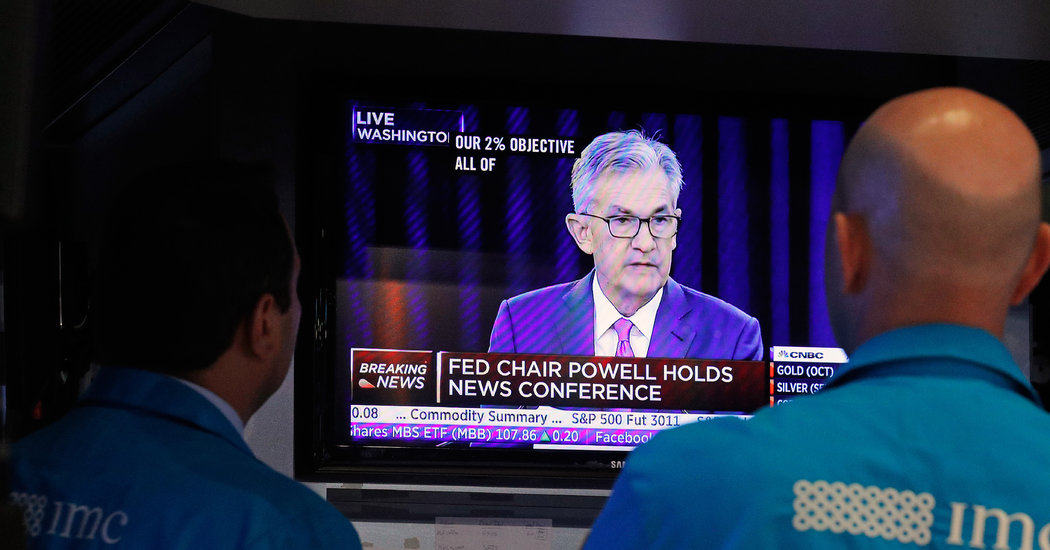Several of the questions directed at Jerome Powell at his Wednesday afternoon news conference boiled down to this: Why did you just cut interest rates when, by your own acknowledgment, the American economy looks perfectly solid? What good can this possibly achieve?
Mr. Powell, the Federal Reserve chair, answered by ticking off the reasons — persistently low inflation and a troubled world economy that poses risks to the United States — for the Fed policy committee’s move.
But there is a broader way to interpret it.
The quarter-percentage-point cut to the target interest rate is really about trying to apply the lessons that the last decade have taught us. It is not a recession-fighting measure per se, but a recalibration, and an implicit acknowledgment that the Fed made a mistake last year by raising interest rates to nearly 2.5 percent.
In particular, the Fed in 2018 was overly confident that it could apply pre-2008 rules of thumb about what constitutes “normal” policy, what causes inflation, and how the Fed’s actions are likely to reverberate around the world. Wednesday’s action was about trying to undo that damage.
The action telegraphs that the Fed is willing to act to keep the economy on its growth path even in the absence of decisive evidence that the economy is slowing, which bodes well for the decade-long expansion to continue through next year’s presidential election and beyond.
But most important, it signals the death knell of an approach to setting monetary policy. The central bank had been slow to adjust to years of low growth, low inflation and international blowback whenever it moved to tighten the money supply.
An episode in late 2015 was one such example. The Fed was making plans to begin raising interest rates — to “normalize” them, as its officials often said, believing that the United States job market was returning to full health, and that there would be an outbreak of inflation if it didn’t act.
But the shift toward tighter policy contributed to a rising dollar and a slowing in the world economy that in turn walloped American energy, agriculture and heavy industry companies, and nearly pulled the entire economy into recession. A turnaround came when the Fed backed away from its plans for interest rate increases through most of 2016.
Similar pressures have been building in the last few months, with a slowdown in much of the world economy, this time linked to trade wars. One way of interpreting the Fed’s interest rate cut Wednesday is that Mr. Powell wanted to react more pre-emptively than he and his colleagues did in late 2015. The hope is that the economy does not experience the same kind of slump in 2020 that it did in 2016.
There is less and less evidence to support the rationale for the earlier rounds of interest rate increases: that the economy was at risk of overheating and so higher rates were needed to forestall inflation. The unemployment rate has been at or below 4 percent for nearly a year and a half, yet prices continue rising more slowly than the 2 percent the Fed aims for. And if anything, growth in workers’ wages — the channel by which a tight labor market is expected to fuel inflation — has leveled out in recent months rather than accelerated.
It is becoming more clear than ever that we should not expect interest rates in the United States to return to their pre-2008 norms anytime soon. Consider that 30-year Treasury bonds are yielding only around 2.5 percent — implying that global investors with trillions of dollars on the line do not anticipate a quick end to the era of low rates.
So to make sense of what Mr. Powell and his colleagues did, don’t look for some particular data point that persuaded them interest rates were too high, or for an argument that slightly lower borrowing costs will unlock significantly more business investment or consumer spending.
Rather, think of it as a corrective action, aimed at undoing a mistake in 2018.
Unfortunately, that makes forecasting what the central bank will do next particularly tricky — and Mr. Powell’s news conference didn’t help matters.
He described the action as a “midcycle adjustment.” That fueled a stock market sell-off, as traders interpreted it to mean that there may not be the further rate cuts that have been reflected in asset prices.
Later, Mr. Powell added that he was not saying necessarily that this would be the only rate cut, only that it is not envisioned as the first in a long series of them.
This may be less of a communication failure and more of a genuine uncertainty within the Fed over whether to act again in light of solid economic data in recent weeks. Two Fed officials dissented from this week’s rate cut, so Mr. Powell could face a tricky task if he pushes for a further move later in the year.
And this strategy does have risks. Lower interest rates against the backdrop of a solid economy may fuel financial bubbles that eventually bring the expansion to an end, which was probably a consideration of the dissenters.
Moreover, Mr. Powell has come under sustained pressure from President Trump to lower rates, and no matter how much Fed officials insist their decisions are driven by economics rather than politics, perceptions can be hard to change.
But the best approach to understanding what the Fed is likely to do next isn’t: “What is President Trump tweeting about them?” or even “How is this month’s jobs report?” or “What is G.D.P. growth going to be this quarter?”
Rather, it’s: How much more readjustment is going to be needed to get the Fed’s interest rate policies in line with the economy we’re living in — one where the gravitational pull of slow growth, an aging work force and low inflation is the reality nearly everywhere?

